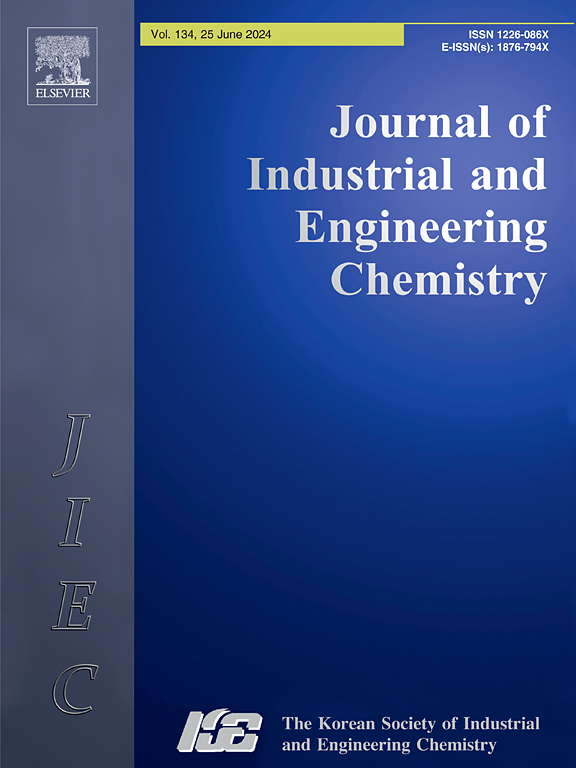Enhancing the visible-light-catalytic activity of MIL-125(Ti)- based nanocomposites by adjusting the structure of the surface ligand: Mechanism and performance
IF 5.9
3区 工程技术
Q1 CHEMISTRY, MULTIDISCIPLINARY
Journal of Industrial and Engineering Chemistry
Pub Date : 2024-10-28
DOI:10.1016/j.jiec.2024.10.061
引用次数: 0
Abstract
To further understand the structure impact of surface ligands on the performance of MIL-125(Ti), two molecules (TBPETC and TPETA) with different structures were designed to surface-modify MIL-125(Ti). The characterizations of powder X-ray diffractometry, Fourier transform infrared spectra, scanning electron microscope, transmission electron microscopy and energy-dispersive X-ray spectroscopy indicate the successful preparation of two novel nanocomposites, TBPETC@MIL-125(Ti) and TPETA@MIL-125(Ti). The photoelectrochemical properties of the materials were characterized by UV–visible spectroscopy, UV–visible diffuse reflectance spectra, photoluminescence spectroscopy and electrochemical impedance spectroscopy, respectively, which indicate both nanocomposites have lower bandgap energy and higher electronegativity than MIL-125(Ti). Under visible light irradiation, the removal percentage of tetracycline hydrochloride (TC) by TBPETC@MIL-125(Ti) and TPETA@MIL-125(Ti) were 91 % and 76 %. The active species capture experiments and HPLC-MS analysis indicated that ![]() O2– and h+ were the predominate active substances and TC can be degraded into small molecules. In addition, the two nanocomposites showed good performance in practical applications, reusability and stability. All the results demonstrate that the effect of conjugate structures of the surface ligand on the properties of the nanocomposites is larger than that of functional groups, and TBPETC@MIL-125(Ti) is an effective material for degradation of TC under visible light in real environment.
O2– and h+ were the predominate active substances and TC can be degraded into small molecules. In addition, the two nanocomposites showed good performance in practical applications, reusability and stability. All the results demonstrate that the effect of conjugate structures of the surface ligand on the properties of the nanocomposites is larger than that of functional groups, and TBPETC@MIL-125(Ti) is an effective material for degradation of TC under visible light in real environment.

求助全文
约1分钟内获得全文
求助全文
来源期刊
CiteScore
10.40
自引率
6.60%
发文量
639
审稿时长
29 days
期刊介绍:
Journal of Industrial and Engineering Chemistry is published monthly in English by the Korean Society of Industrial and Engineering Chemistry. JIEC brings together multidisciplinary interests in one journal and is to disseminate information on all aspects of research and development in industrial and engineering chemistry. Contributions in the form of research articles, short communications, notes and reviews are considered for publication. The editors welcome original contributions that have not been and are not to be published elsewhere. Instruction to authors and a manuscript submissions form are printed at the end of each issue. Bulk reprints of individual articles can be ordered. This publication is partially supported by Korea Research Foundation and the Korean Federation of Science and Technology Societies.

 求助内容:
求助内容: 应助结果提醒方式:
应助结果提醒方式:


